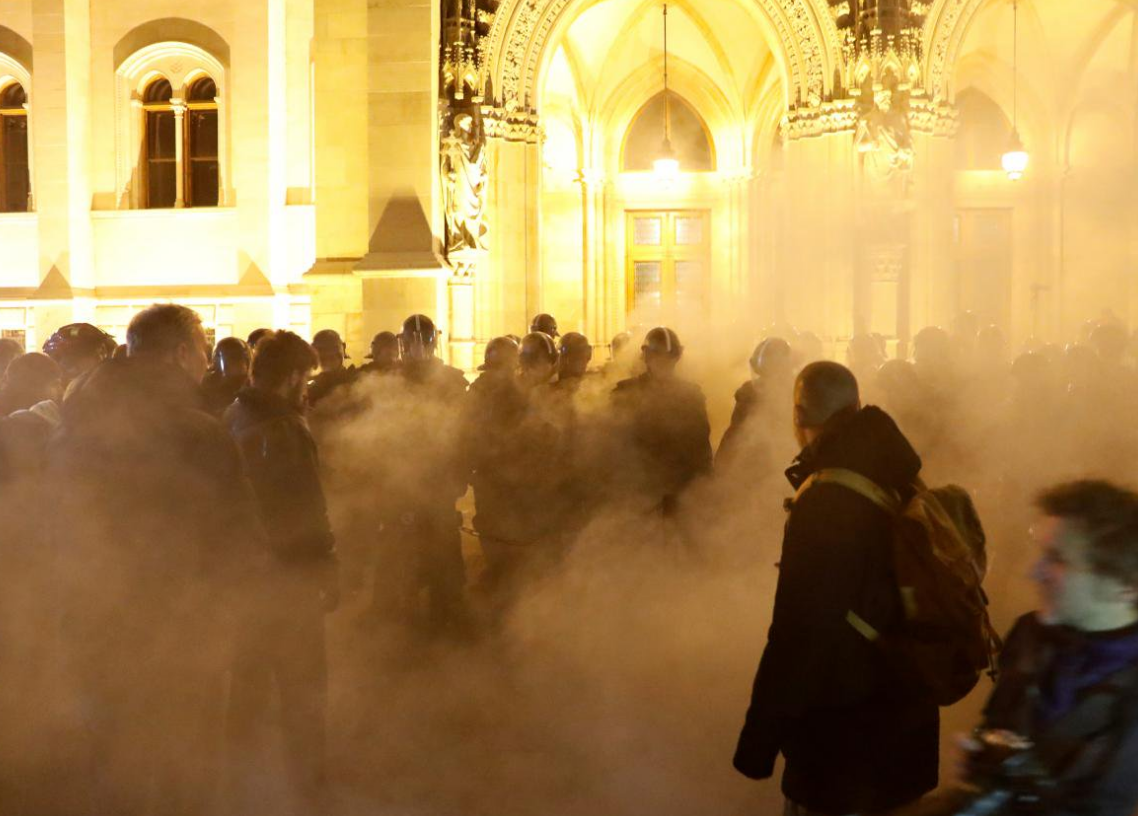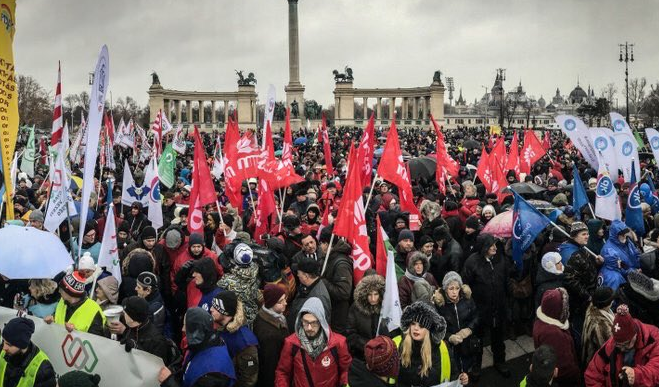The Hungarian working class is awakening and radical students are paving the way for nationwide protests. Since mid-December, a protest movement has been rolling across the country against the extension of working hours. Prime Minister Victor Orbán is under pressure for the first time.
Read the article in Hungarian |
On 12 December, Fidesz, the ruling party since 2010, pushed a new counter-reform to the Working Hours Act – also known as the “slave law” – through parliament using its supermajority. This new measure will make it legal for employers to demand 400 hours of overtime per year, and overtime wages will not have to be paid for three years. In fact, this means the nationwide introduction of a six-day-week, or a 14-month-year. Orbán emphasises that this increased overtime is “voluntary” and that “Hungarians want to work longer”.
For most of the period after the reintroduction of capitalism in Hungary (in the early 1990s), the Social Democrats (ex-Stalinists) were in government, often in alliance with the liberals. The last government of this kind – which acted as a letting agent to oversee Hungary’s sale to Western companies – collapsed in 2010 in a swamp of lies and a near-state-bankruptcy. The house of cards came down as the masses’ political illusions in reformism collapsed and opened the way to Orbán to come to power. Orbán has used whatever economic resources were available to develop a Hungarian bourgeoisie and secure a clientele of some two million Fidesz voters. Thus, economic growth and demagogically using the political desperation of the masses are central support columns of his rule.
“Bailiff of the corporations”
In contrast to his nationalist rhetoric and open racism, Orbán’s political-economic model is fully dependent on international capital. Infrastructural funds from the EU and German automobile companies are economically decisive, second only to economic contracts with China and Russia.
EU subsidies account for up to 5 percent of Hungarian economic output. They flow into a network of Orbán-affiliated company networks. The most well-known of the new class of Hungarian ‘state capitalists’ is the plumber Mészáros, whose wealth has increased twenty-fold within a few years, and in 2017 alone founded 82 new companies and raised €1 billion in state contracts.
Mészáros’ wealth is estimated at €350 million. But this corresponds only to the annual profit of the Hungarian subsidiary of the German carmaker Audi. Opel, Mercedes-Benz, Suzuki and BMW generate about a third of Hungarian exports and employ tens of thousands of workers. The Hungarian government guarantees these corporations the highest profits and the lowest taxes (9 percent), a low social security contribution (less than 20 percent of the wage) and vast amounts of labour. Meanwhile, expenditure on education and the social system is being permanently reduced, while it is literally perilous to be admitted to a Hungarian public hospital and not to have money to bribe the doctors.

In almost all factories, the production flows were established before there was any workers’ representation. Accordingly, conditions are highly exploitative, and strikes were de facto banned in 2013. Wages in Hungary are the third-lowest in the EU. In order to ensure that the huge assembly halls do not run out of poorly paid workers, working hours have already been extended in recent years, compulsory school attendance has been cut by one year, access to universities for working-class children has been made more difficult and compulsory internships for students in production introduced.
But this feeble economic model is under pressure. On the one hand, powerful forces are pushing for EU regional aid to be cut back to Eastern Europe. On the other, the general economic slowdown means a reduction in investments. At the same time, the development model of Hungary, as the assembly hall of Europe, is running out of a labour force. Between half a million and one million working Hungarians have moved abroad in search of a better life. The “slave law” therefore has two meanings: it enslaves the Hungarian workers to their companies, and it is also an expression of Orbán’s weakness, planted as he is under the heels of the western capital, mainly German. The bosses of the multinationals benefit a great deal from the investment climate in Hungary, where wages are low, unions weak, taxes are minimal and the state is willing to do anything to accommodate them.
Street protests
Already, at the beginning of December, there were smaller protests for increased wages, against the new labour law and against Orbán’s rule in general. Initially, there were 2-3,000 students and workers blocking some of the Danube bridges, marching to the government building and trying to break through police barriers and enter parliament.
Union leaders in Hungary have called for a national strike and protests on January 19 to oppose labour code changes they see as a "slave law" harmful to workers. https://t.co/oi750kCDLQ @ituc pic.twitter.com/3i74NVJpqC
— LabourStart (@labourstart) January 6, 2019
In the following days, these protests escalated, until finally, on 16 December, 20,000 people were on the streets of Budapest demonstrating against Orbán and his Fidesz party. Workers, students, politicians from all opposition parties, trade unions and NGOs flocked to the demo. EU flags, flags of the far-right JOBBIK party, but also red flags were waved: a novelty on the streets of Budapest. For the first time, many people also joined demonstrations in smaller cities, such as Györ, Szeged, Miskolc, Debrecen, Veszprém and Békescsaba. Slogans were very general and included: “Orbán: fuck off”, “Democracy”, “It's enough.” The best known is probably: O1G (“Orbán egy geci” / “Orbán is ejaculate/shit”). Of course, years of state propaganda as well as countless betrayals by the so-called labour leaders means that the there is a great political confusion amongst the masses. Nevertheless, these events represent a backlash against the ruling establishment.
During the demonstrations, some MPs from the opposition parties tried to get into the state television building (MTV) to read out the demands of the demonstrators. This is symbolically reminiscent of the Hungarian Revolution of 1956, whose memory is very much alive in Hungarian society.
Orbán falls: capitalism falls
The masses have been awakened by Orbán’s inhumane reform and forced onto the streets. In 2017, there were major protests over the expulsion of the Central European University from the country. These protests were very peaceful (“holding hands for democracy”) and were left alone by the police. The current movement has a new character: it is not the anxious, liberal, middle classes that are taking to the streets, but radical young people and angry workers, more than a few in ‘yellow vests.’ People are enormously dissatisfied and have developed an awareness that class exploitation from above must be opposed by solidarity from below. The state apparatus is reacting, and for the first time, the police are cracking down. Meanwhile, the Fidesz-controlled media is firing on all cylinders: the official number of demonstrators is being underestimated and described as a mix of Christian-haters, jews and anarchists who were all recruited by George Soros.
The Fidesz apparatus definitely wants to prevent backward layers of the working class from being drawn into the movement, but in the context of the enormous pressures piling up on these layers, it is more than likely that this will happen sooner or later. In contrast to the liberal pseudo-criticism of Orbán’s regime, today the material life of the working class is at the center of the resistance to Orbán.
The most dynamic part of the movement is the students. At the end of 2018, a union (‘Hallgatói Szakszervezet’) was founded by social sciences students. Their initial goal was to fight for student rights, against high tuition fees, the low number of scholarships and high rents; and for academic freedom in general. Since the introduction of the ‘slave law’, they have broadened their perspectives and are fighting side by side with trade unions, especially the metalworkers: the most militant union. They play a central, and sometimes leading role in the protests (especially street blockades).
Protesters poured into the streets of Budapest by the thousands the past few nights calling for Hungary’s Prime Minister, Viktor Orban, to “reconsider it!” The policy to be reconsidered is what Hungary’s workers are calling the government’s new “slave law” https://t.co/LsCwyMOUOK pic.twitter.com/cVDw0kkVXN
— CounterPunch (@NatCounterPunch) December 21, 2018
Their most important slogan is "workers and students together". Most trade unions are very cautious in their approach. Usually, they give the government an ultimatum and, according to internal debate and criticism, threaten a general strike that the leadership of the unions themselves do not really believe in. In reality, the union leaders hope that, for the first time, they will be recognised as negotiating partners by the Orbán government.
Important for the immediate continuation of the fight will be the events of 19 January: the next nationwide day of action, which is mainly being coordinated on social media. But regardless of how this round of strike action works out, the struggle against the slave law is a turning point in Hungary's recent history. Labour disputes, which could have been counted on one hand in recent years, will increase. This will result from the new law, combined with the general shortage of labour, which gives the workers more leverage, and above all, the political awakening of the working class and youth.
The student organisations, which are already the most important source of inspiration for the working-class activists, could play a central role in this process. The popular slogan “Free Students: Free Workers” in the eyes of the International Marxist Tendency signifies the liberation of the working class and youth from the crisis-ridden capitalist system, because the crisis in Hungary is only one expression of an international capitalist crisis.
The authoritarian, ruling mafia bourgeois, managing the cheap workbench of foreign corporations, corresponds to what capitalism has to offer the working class in Europe’s ‘periphery’. The unequal integration of Hungary into the world market objectively does not allow for a decent life for workers and their families through reforms within capitalism. Therefore, we say: no to the slave law, down with Orbán, for the United Socialist States of Europe!
Correction (18/01/19): due to an error, a previous version of this article linked to a German version rather than Hungarian, as stated. We apologise for the mistake.

